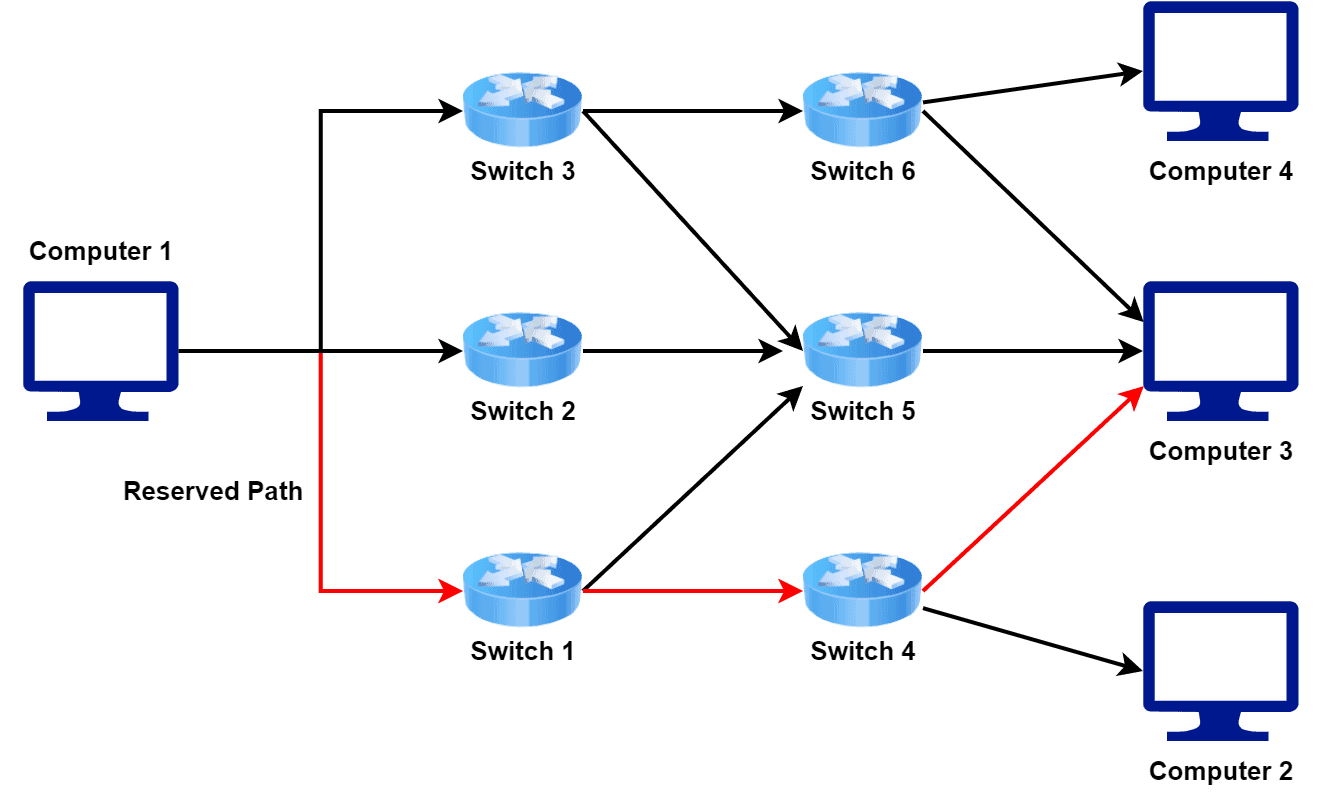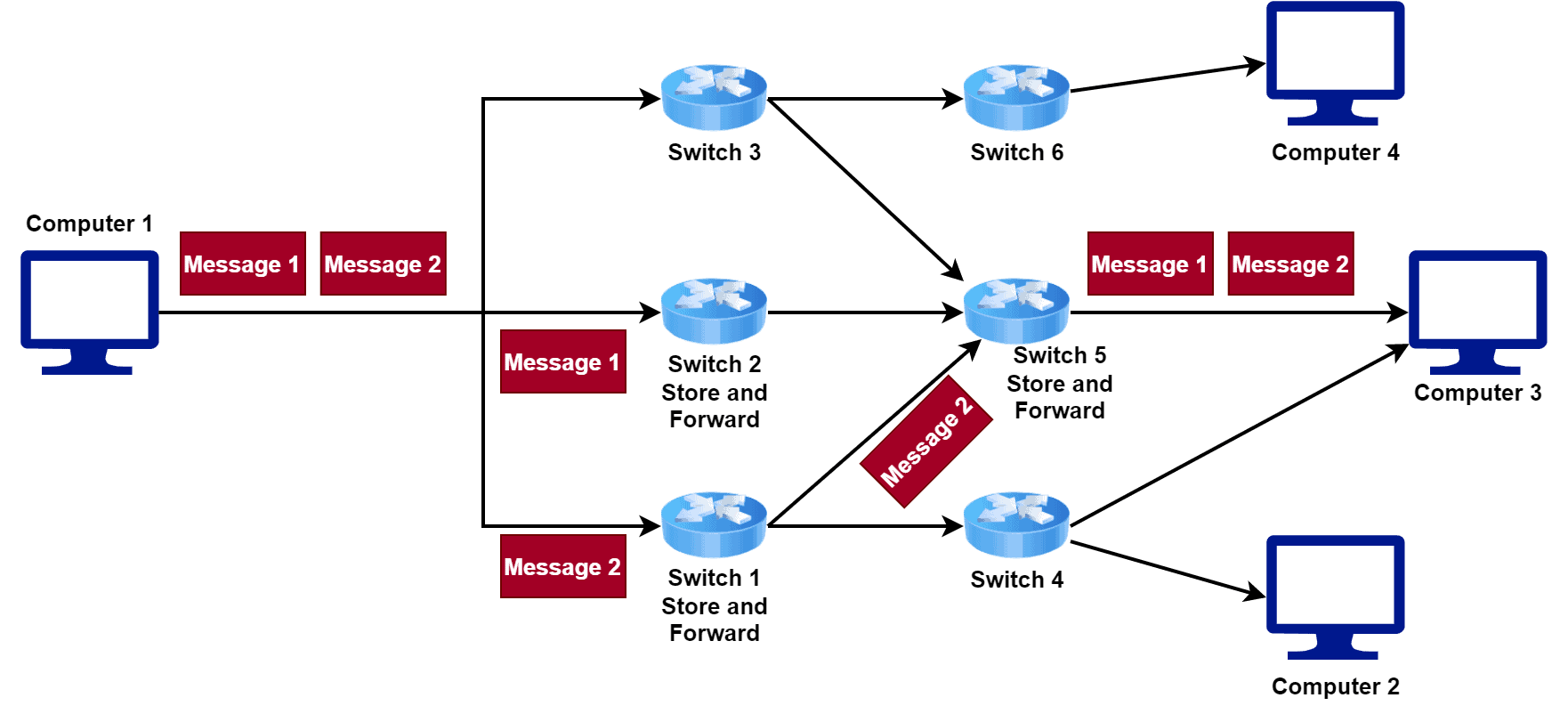1. Overview
In this tutorial, we’ll discuss three popular network-switching techniques: circuit, packet, and message switching. We’ll present the general idea behind each of these switching techniques.
Finally, we’ll highlight some advantages and disadvantages of each switching technique.
2. Introduction to Switching
We use switching techniques in computer networks to connect devices and allow them to communicate with each other. Additionally, we can utilize switching techniques to transfer data from one device to another.
Switching allows multiple devices to share the same communication channel simultaneously. As a result, it improves the efficiency of the network. Furthermore, switching also enables the network to route data to its intended destination. Additionally, it provides a mechanism for error checking and correction.
There’re three main switching techniques used in computer networks: circuit switching, packet switching, and message switching. Let’s discuss them comprehensively.
3. Circuit Switching
3.1. Introduction
We mainly use circuit switching in traditional telephone networks. When two devices want to communicate in a circuit-switched network, they establish a connection by setting up a dedicated path between them. This path is reserved exclusively for the duration of the communication. Hence, no other devices can use it during that specific time.
Once we establish the connection, we can transfer data between devices over the dedicated path. This path typically comprises a series of interconnected switches or nodes that route the data to its destination.
Let’s take a look at the general architecture of a network where we use circuit switching technique to transfer data from Computer 1 to Computer 3:

Circuit switching isn’t commonly used in computer networks, as it isn’t very efficient for data transmission. We reserve the dedicated path for the entire duration of the communication. Therefore, we waste a significant amount of bandwidth during those times. Additionally, circuit switching is not well-suited for networks with high traffic volumes.
However, we still use circuit switching in some specialized applications, such as in satellite communications, where the delay of packet switching can be prohibitive.
3.2. Advantages
Let’s discuss some advantages of circuit switching.
Circuit switching provides a dedicated communication path between two devices for the duration of the communication. Hence, we reserve the bandwidth for the entire conversation. This results in guaranteed bandwidth, which can be important for applications that require a constant data rate.
As we reserve the dedicated communication for the entire conversation, there’s no packet loss. Finally, circuit switching provides predictable performance.
3.3. Disadvantages
Some major disadvantages make it less suitable for modern computer networks. Let’s discuss some disadvantages of circuit switching.
Circuit switching requires the dedicated communication path to be reserved for the entire duration of the communication. This results in an inefficient use of bandwidth, as the dedicated path isn’t being utilized during these times.
Circuit switching isn’t well-suited for networks with high traffic volumes. This limits the scalability of circuit switching in large networks.
Finally, it requires dedicated resources, such as switches or nodes, to establish the dedicated communication path. This can result in high costs for establishing and maintaining circuit-switched networks.
4. Packet Switching
4.1. Introduction
Packet switching is a method used to transmit data over a network. We divide data into small packets and transmit them over the network independently. Each packet contains the data and destination address information required to route the packet to its destination.
In packet switching, each packet travels separately through the network and can take different paths to reach its destination. This approach allows for more efficient use of network resources because we can transmit multiple packets simultaneously over the same network.
Let’s take a look at a network where we use packet switching technique to transfer data from Computer 1 to Computer 3:

Packet switching is the basis for the Internet, which uses the Transmission Control Protocol/Internet Protocol (TCP/IP) suite of protocols for communication between devices. In this system, we transmit packets between devices, and routers along the way use the destination address information in each packet to route it to the next hop until it reaches its destination.
4.2. Advantages
Packet switching offers several advantages over other data transmission methods, such as circuit switching. Let’s discuss some of the key benefits of packet switching.
It allows multiple packets to be transmitted simultaneously over the network, making more efficient use of the available bandwidth.
Packet switching is a robust and reliable method of data transmission. If one packet is lost or delayed, it doesn’t affect the transmission of other packets, as we route packets independently through the network.
Packet switching is highly flexible. It can easily adapt to changing traffic patterns and network conditions.
4.3. Disadvantages
While packet switching offers many advantages, there’re also some potential disadvantages.
The process of breaking data into packets and adding header information to each packet can introduce additional overhead and latency into the transmission process. This can increase the time required for packets to reach their destination. Additionally, it can reduce the overall speed of data transmission.
It can be vulnerable to security threats such as packet sniffing. This can compromise the privacy and security of data transmitted over the network. Furthermore, it can be complex to set up and manage, particularly in larger or more complex networks.
5. Message Switching
5.1. Introduction
Message switching is a method of data transmission that was popular in the early days of networking, before the development of packet switching. In message switching, we divide a message into fixed-length blocks or frames.
Furthermore, we transmit each frame independently through the network. Additionally, each intermediate node stores the frames until the entire message is received. Finally, the nodes forward the entire message to its destination.
Unlike packet switching, message switching is a store-and-forward method of data transmission. It means that each intermediate node stores the entire message until it can be forwarded to the next node. This can result in longer transmission times compared to packet switching. We can only transmit each message when an intermediate node receives all the parts of the message.
Let’s take a look at a network where we use message switching technique to transfer data from Computer 1 to Computer 3:

5.2. Advantages
While message switching is an older method of data transmission that has largely been replaced by packet switching, it does offer some advantages.
Message switching is a highly reliable method of data transmission. Each intermediate node stores the entire message until it can be forwarded to the next node. This reduces the risk of data loss or corruption, as we store each message at intermediate nodes before forwarding them.
It’s a simple method of data transmission that doesn’t require complex routing algorithms or network management techniques. This makes it easy to implement and manage, particularly in small or low-bandwidth networks.
Message switching has a lower overhead compared to other methods of data transmission. This means that more bandwidth is available for data transmission.
5.3. Disadvantages
It has several disadvantages compared to other methods.
Message switching has a higher latency compared to other methods, such as packet switching. Additionally, it can be inefficient in terms of network resource utilization because each intermediate node must store the entire message until it can be forwarded.
Finally, it requires more network resources for each message. This means that message-switching networks may be unable to support large numbers of devices or high-bandwidth applications.
6. Conclusion
In this tutorial, we discussed three popular network-switching techniques: circuit, packet, and message switching. We presented the general idea behind each of these switching techniques.
Finally, we highlighted some advantages and disadvantages of each switching technique.